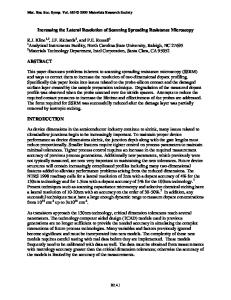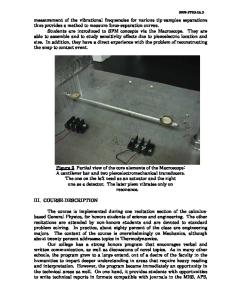Scanning Spreading Resistance Microscopy For 3D-Carrier Profiling in FinFET-based Structures
- PDF / 1,263,335 Bytes
- 7 Pages / 612 x 792 pts (letter) Page_size
- 57 Downloads / 275 Views
1070-E01-11
Scanning Spreading Resistance Microscopy For 3D-Carrier Profiling in FinFET-based Structures Jay Mody1,2, Pierre Eyben2, Wouter Polspoel1,2, Malgorzata Jurczak2, and Wilfried Vandervorst1,2 1 Electrical Engineering Department, INSYS, Katholieke Universiteit Leuven, Kasteelpark Arenberg 10, Leuven, B-3001, Belgium 2 IMEC vzw, Kapeldreef 75, Leuven, B-3001, Belgium ABSTRACT Junction formation in FinFET-based 3D-devices is a challenging problem as one targets a complete conformal doping of the source/drain regions in order to produce equal gate-profile overlaps (and thus transistor behavior) on all sides of the fins. Due to the lack of predictive modeling for several of the doping strategies explored (plasma immersion, cluster implants, vapor phase deposition, etc…) it becomes difficult to correctly predict the performance of the devices and hence, accurate 3D-doping profile determination is desired. Although several dopant/carrier profiling methods exist with excellent one- or two-dimensional resolution and properties, there is an urgent need to extend these towards a quantitative three-dimensional geometry. In this work, we use scanning spreading resistance microscopy (SSRM) with dedicated FinFET test structure to obtain three-dimensional information from successive twodimensional scanning spreading resistance maps. We also assess the validity of our methodology by comparing various sections along the fins which represent the variability due to the processing and measurement procedure. INTRODUCTION Due to the excellent scaling properties of a FinFET over its planar counterpart, these 3Ddevices are being considered as promising candidates for the 32nm technology node and beyond. The performances of FinFET-based devices are determined by the size of the fins and as with any transistor, the distribution of electrically active dopants (carriers) in the source/drain regions and the gate-overlap [1-3]. Given the small size of the fin (typically 15nm x 65nm), the metrology requirements are somewhat different as compared to planar devices. Indeed since the source/drain regions will in general no longer have a junction depth but will be (ideally) homogenously doped, the most relevant information is the lateral dopant diffusion under the 3Dgate material. The processes governing this lateral extension (on all sides of the fin) are inherently linked with the technology used to dope the sidewall (implant vs. plasma doping vs. vapor phase doping, etc…) and the subsequent thermal treatments. Unfortunately, these processes are not necessarily isotropical and thus simple one-dimensional experiments to mimic the doping process in the fin are of very little value. As a consequence, there is an urgent need for a quantitative 3D-carrier concentration mapping technique which can particularly probe in FinFET-based devices with sub-nm resolution. Presently there is no accepted technique that can quantitatively map 3D-carrier distribution and only the Tomographic Atomprobe [4] contains the potential to probe the 3Ddopant distrib
Data Loading...










